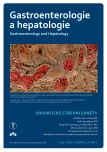Receptor mechanisms mediating activation of esophageal nerves by acid
Authors:
P. Bánovčin Jr; M. Ďuriček; R. Hyrdel
Authors‘ workplace:
Interná klinika gastroenterologická JLF UK a UN Martin, Slovenská republika
Published in:
Gastroent Hepatol 2017; 71(1): 53-57
Category:
Clinical and Experimental Gastroenterology: Review Article
doi:
https://doi.org/10.14735/amgh201753
Overview
The pH in the esophageal lumen can be very low (pH 1) during acidic reflux. However, the pH in the esophageal mucosa where the esophageal afferent nerves terminate is predicted to be much higher (pH 5.5– 6.5). This is because the esophageal mucosal barrier, even when reduced in gastroesophageal reflux disease, still prevents most acid from diffusing into the esophageal tissue and causing widespread cellular death. It has therefore been predicted that the esophageal nociceptive (pain- and heartburn-mediating) nerves are stimulated by modest acid (pH 5.5–6.5) and express highly sensitive acid receptors. Recent studies in a guinea pig model demonstrated that weak acid (pH 5.5– 6.5) robustly stimulates esophageal spinal nociceptive C-fibers. Consistent with this observation, gene expression analysis revealed that esophageal C-fibers redundantly express multiple acid sensing ion channels (ASICs), proton-sensing G-protein coupled receptor OGR1, and the highly acid sensitive two-pore-domain (K2P) TASK1-family potassium channel. The high acid sensitivity of esophageal nociceptive nerves contributes to heartburn and pain in conditions of reduced mucosal barrier function (e. g. GERD), suggesting that the receptors mediating this high acid sensitivity could be targeted by novel drugs as a combinatorial therapy with, or an alternative to acid suppression.
Key words:
esophagus – gastroesophageal reflux disease – GERD – heartburn – acid sensing ion channel
The authors declare they have no potential conflicts of interest concerning drugs, products, or services used in the study.
The Editorial Board declares that the manuscrip met the ICMJE „uniform requirements“ for biomedical papers.
Submitted:
20. 8. 2015
Accepted:
3. 10. 2016
Sources
1. Page AJ, Blackshaw LA. Roles of gastro-oesophageal afferents in the mechanisms and symptoms of reflux disease. Handb Exp Pharmacol 2009; 194: 227– 257. doi: 10.1007/ 978-3-540-79090-7_7.
2. Orlando RC. Pathophysiology of gastroesophageal reflux disease. J Clin Gastroenterol 2008; 42(5): 584– 588. doi: 10.1097/ MCG.0b013e31815d0628.
3. Boeckxstaens GE, Rohof WO. Pathophysiology of gastroesophageal reflux dis-ease. Gastroenterol Clin North Am 2014; 43(1): 15– 25. doi: 10.1016/ j.gtc.2013.11. 001.
4. Dusenkova S, Ru F, Surdenikova L et al. The expression profile of acid sensing ion channel (ASIC) subunits ASIC1a, ASIC1b, ASIC2a, ASIC2b and ASIC3 in the esophageal vagal afferent nerve subtypes.Am J Physiol Gastrointest Liver Physiol2014; 307(9): G922– G930. doi: 10.1152/ ajpgi. 00129.2014.
5. Ru F, Banovcin P Jr, Kollarik M. Acid sensitivity of the spinal dorsal root ganglia C-fiber nociceptors innervating the guinea pig esophagus. Neurogastroenterol Motil 2015; 27(6): 865– 874. doi: 10.1111/ nmo.12561.
6. Tanaka S, Chu S, Hirokawa M et al. Direct measurement of acid permeation into rat oesophagus. Gut 2003; 52(6): 775– 783.
7. Ru F, Surdenikova L, Brozmanova M et al. Adenosine-induced activation of esophageal nociceptors. Am J Physiol Gastrointest Liver Physiol 2011; 300(3): G485– G493. doi: 10.1152/ ajpgi.00361. 2010.
8. Brozmanova M, Ru F, Surdenikova L et al. Preferential activation of the vagal nodose nociceptive subtype by TRPA1 agonists in the guinea pig esophagus. Neurogastroenterol Motil 2011; 23(10): e437– e445. doi: 10.1111/ j.1365-2982.2011.01768.x.
9. Yu S, Ru F, Ouyang A et al. 5-Hydroxytryptamine selectively activates the vagal nodose C-fibre subtype in the guinea-pig oesophagus. Neurogastroenterol Motil 2008; 20(9): 1042– 1050. doi: 10.1111/ j.1365-2982.2008.01136.x.
10. Yu S, Undem BJ, Kollarik M. Vagal afferent nerves with nociceptive properties in guinea-pig oesophagus. J Physiol 2005; 563 (Pt3): 831– 842.
11. Surdenikova L, Ru F, Nassenstein C et al. The neural crest- and placodes-derived afferent innervation of the mouse esophagus. Neurogastroenterol Motil 2012; 24(10): e517– e525. doi: 10.1111/ nmo.12002.
12. Julius D. TRP channels and pain. Annu Rev Cell Dev Biol 2013; 29: 355– 384. doi: 10.1146/ annurev-cellbio-101011-155833.
13. Holzer P. Acid sensing by visceral affer-ent neurones. Acta Physiol (Oxf) 2011;201(1): 63– 75. doi: 10.1111/ j.1748-1716.2010.02143.x.
14. Liu Q, Tang Z, Surdenikova L et al. Sensory neuron-specific GPCR Mrgprs are itch receptors mediating chloroquine-induced pruritus. Cell 2009; 139(7): 1353– 1365. doi: 10.1016/ j.cell.2009.11.034.
15. Weijenborg PW, Smout AJ, Verseijden C et al. Hypersensitivity to acid is associated with impaired esophageal mucosal integrity in patients with gastroesophageal reflux disease with and without esophagitis. Am J Physiol Gastrointest Liver Physiol 2014; 307(3): G323– G329. doi: 10.1152/ ajpgi.00345.2013.
16. Farré R, Blondeau K, Clement D et al. Evaluation of oesophageal mucosa integrity by the intraluminal impedance technique. Gut 2011; 60(7): 885– 892. doi: 10.1136/ gut.2010.233049.
17. Jovov B, Que J, Tobey NA et al. Role of E-cadherin in the pathogenesis of gastroesophageal reflux disease. Am J Gastroenterol 2011; 106(6): 1039– 1047. doi: 10.1038/ ajg.2011.102.
18. Weijenborg PW, Rohof WO, Akkermans LM et al. Electrical tissue impedance spectroscopy: a novel device to measure esophageal mucosal integrity changes during endoscopy. Neurogastroenterol Motil 2013; 25(7): 574–578. doi: 10.1111/nmo.12106.
19. Kollarik M, Ru F, Brozmanova M. Vagal afferent nerves with the properties of nociceptors. Auton Neurosci 2010; 153(1–2):12–20. doi: 10.1016/j.autneu.2009.08.001.
20. Harrington AM, Brierley SM, Isaacs NJ et al. Identifying spinal sensory pathways activated by noxious esophageal acid. Neurogastroenterol Motil 2013; 25(10): e660–e668. doi: 10.1111/nmo.12180.
21. Banerjee B, Medda BK, Lazarova Z et al.Effect of reflux-induced inflammation on transient receptor potential vanilloid one (TRPV1) expression in primary sensory neurons innervating the oesophagus of rats. Neurogastroenterol Motil 2007; 19(8): 681–691.
Labels
Paediatric gastroenterology Gastroenterology and hepatology SurgeryArticle was published in
Gastroenterology and Hepatology

2017 Issue 1
Most read in this issue
- Skin conditions in patients with inflammatory bowel diseases
- When is celiac disease not celiac disease?
- Ginkor Fort® with ginkgo biloba extract
- Are there any changes in the surgical management of stenosing rectal cancer?
